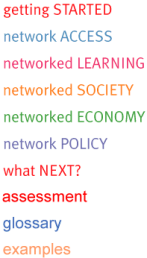|
||
Readiness depends upon the community's incorporation of information and communication technologies into the fabric of its activities in order to maximize the gains of joining in the Networked World. In society-at-large, ICTs can have a profound effect upon people's professional and personal lives by providing easier access to information, more efficient ways to communicate and powerful organizational tools. To understand how a community is using ICTs, it is important to assess not only how many members of the community have access to the technologies, but also how they are using them. People and Organizations Online. One of the hardest indicators to track is the actual number of online users. Particularly in the developing world, where multiple users share many electronic mail (e-mail) accounts and other online tools, there are few reliable indicators that accurately map how many people are online. The exponential growth in online usage also makes tracking current use difficult. This is nevertheless an important indicator. As more people access the Internet regularly, and networks of users grow, there is greater demand and opportunity for online interaction, as well as better meshing with the Networked World at-large. As more organizations gain an online presence, it becomes more likely that the community will use information and communication technologies to augment or carry out its activities and needs. One of the most important drivers of online growth is awareness - people must first know and understand what the Internet is in order to participate. Particular attention should be paid to the demographics of Internet users in the community. Particularly at lower stages of Readiness, groups such as women, the physically disabled, and racial and ethnic minorities often do not participate in the online environment. A community is more Ready when there are not large discrepancies in online presence among different groups. Locally Relevant Content. Community members find the Internet medium more useful and relevant to their own lives when online content reflects their own interests and needs. Locally relevant content is a major driver of growth of Internet usage. Interactions such as chat rooms, online interest groups, special interest software, bulletin boards, listservs and websites all drive the community to use ICTs more widely in their lives. Similarly, online content is more relevant when it is available in local languages. English language dominance on the Internet remains a serious impediment to the world's non-English speaking communities. While the preponderance of English is waning, and other world languages are gaining, most of the world does not speak a language that is strongly represented either in software or on the World Wide Web. Information and Communication Technologies in Everyday Life. Communities participate more directly in the Networked World when information devices, such as radios, faxes, televisions, telephones, pagers and computers are culturally accepted and widely incorporated into daily life. It is important to examine both penetration of ICT devices into a community and their applications. In communities where either income levels or the network infrastructure cannot support high levels of individual access, public shared facilities provide a needed alternative. Such venues may include telecenters, cybercafes and community information centers. Strategies for drawing people in to use these facilities are essential. Information and Communication Technologies in the Workplace. The more that business and government offices are already using information and communication technologies, the better prepared they are to participate in the global networked economy. In order to realize important efficiency gains from ICTs, businesses and governments need to not only make technologies available to their employees, but also effectively incorporate them into their core processes. |
||



